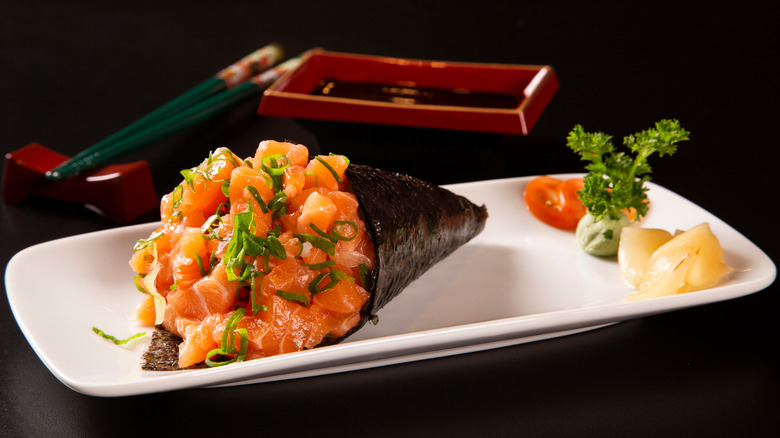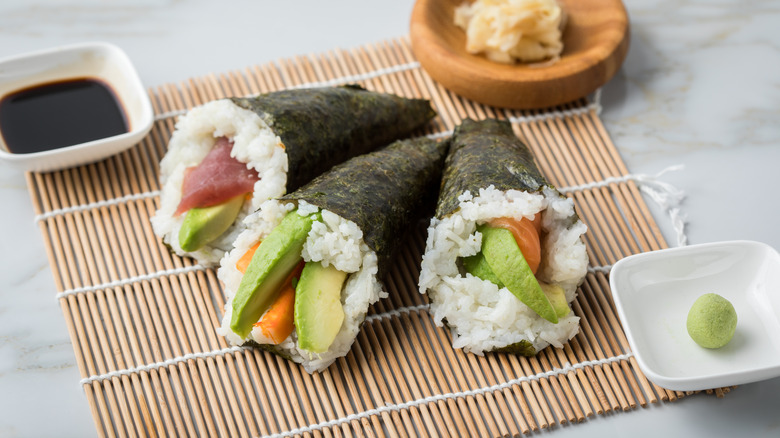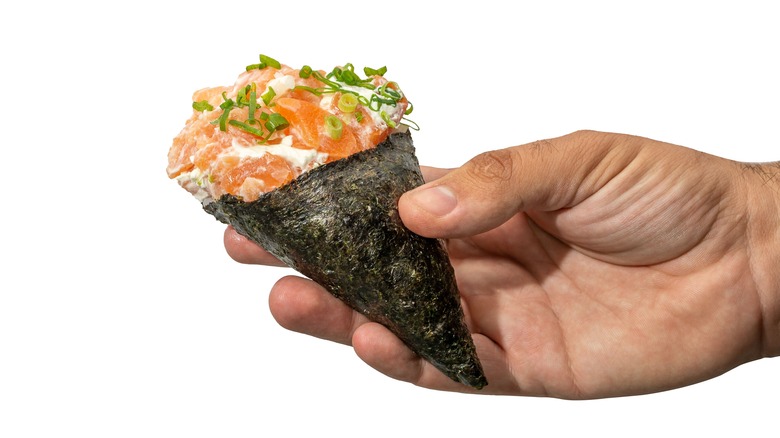What Is Temaki And How Do You Eat It
Sushi menus are filled with hundreds of different items, but if you were to look closely, you'd notice that all the many variations of sushi could be grouped into five broad categories. There's sashimi, which features thin slices of raw fish or shellfish on their own, and nigiri — which are thin slices of fish or shellfish served over pillows of rice. Then come the maki and uramaki, which make up a big chunk of the menu. Where maki is a piece of rolled sushi wrapped in seaweed with rice and filling on the inside (popularly known as a sushi roll as well), uramaki is the exact opposite of it — it is a piece of rolled sushi where the seaweed goes with the toppings on the inside and rice makes the outer layer.
But there's another type of sushi somewhere in between: temaki. Temaki or temakizushi is essentially sushi where the nori (or seaweed) is filled with rice and toppings and then hand-rolled into the shape of a cone. Unlike maki or uramaki — where the sushi is rolled with the help of a bamboo mat and then sliced into several pieces — temaki is rolled by hand into individual size portions and is generally picked up and eaten with hands — no chopsticks for this one!
Some theories claim that temaki is the fast-food version of sushi
Temaki gets its name from the Japanese words for hand (te) and to roll (maki), and there are several theories as to how such sushi came to be. Some claim that it was a restaurant named Tsukiji Tama Sushi, located near Tokyo's Ginza district, that came up with the very first temaki in 1971 in an effort to create a new type of non-traditional sushi that would appease modern youngsters. While this tale makes temaki a relatively new type of sushi, another theory states that this hand-rolled sushi is much older.
According to other versions, temaki has been around since the 19th century in Japan. In the late Edo period, there was a need for a type of sushi that could be enjoyed on the go and was more hassle-free than the traditional eating experience. Some even claim that temaki was born in the gambling dens or tekkabas of Japan where serious gamblers wanted a finger food-like sushi that wouldn't make their fingers messy in the middle of a play. And so the temaki was invented: a type of sushi where everything was packed inside a cone of nori — wasabi, soy sauce, and all — which could be eaten by hand without the need for any plates or bowls, let alone chopsticks. As such, temaki is seen more as a fast food version of sushi that can be grabbed from street food stalls or served at large gatherings.
Leave the chopsticks for another sushi
Temaki is one of the easiest types of sushi to make since it doesn't even require bamboo mats. All you need is half or a quarter sheet of nori with a layer of rice spread on top. On go the toppings — seafood, veggies, whatever you like — after which the nori is carefully rolled from the bottom corner to the top corner into a cone.
Temaki is not only made by hand but it's also eaten by one too, making it one of the rarer Japanese delicacies that don't require the use of chopsticks. Simply grab temaki with your hands and bite into it from the top; if the temaki is any good, you won't even have to worry about the fillings falling out as a tightly rolled nori will usually be able to hold everything in. This is why it's best to eat temaki as soon as it's made as the nori is still crisp and brittle. The longer it sits out, the softer and chewier the nori will get, making it harder to bite into the temaki.
While it's not usual for temaki to be served alongside the usual accompaniments, which are soy sauce, wasabi, and gari (pickled ginger), some prefer to put the wasabi and soy sauce inside the temaki to make it even more convenient to eat on the go. Regardless of how the accompaniments are served, don't be afraid to roll up your sleeves and bite into temaki with your hands — chopsticks are better left for things like sashimi.



